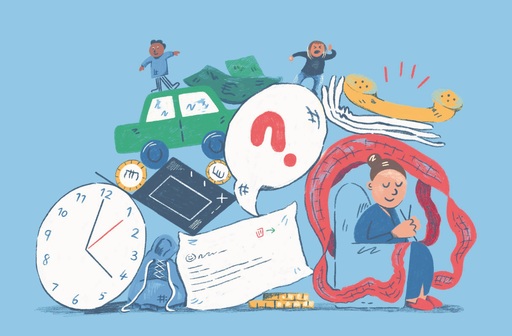Knitting with the Times: How knitting is woven into modern life
Recent years have seen many of us learn the odd cross stitch or two. One writer unpacks the evolving role of knitting in our fast-paced daily lives – from coping mechanism to creative outlet
Like so many of us work-from-homers, my living room contains a carefully set up office space. My little desk nook is designed to eliminate the inevitable distractions of being at home and provide a clear division between the ‘office’ and ‘home’. It includes – carefully piled onto my too-small desk – several monitors, a mouse and keyboard setup, a desk lamp, a bin of pens and post-it notes, and hand cream. Most importantly, it also contains a basket of wool.
“What are you knitting?” my boss will ask in a meeting when spying a glimpse of multicoloured yarn peeking out from the bottom end of the Zoom screen. I grin at him, and show him whatever project is currently on my needles and helping me focus.
Knitting has increasingly become part of our working and digital lives: the term ‘meeting knitting’ has grown in popularity in both office environments and amongst the online knitting community on platforms such as Instagram and YouTube. But not only are we rediscovering a craft that – in a world dominated by fast fashion and busy lifestyles – has long been dismissed as a hobby for elderly folk, we’re also finding new ways in which this craft can benefit us.
Glasgow-based knitwear designer Lydia Morrow says that her knitting practice helps quieten her mind. “I got back into reading this year and it’s because I figured out a whole strategy of balancing a book on my lap whilst still knitting,” says Lydia, who was diagnosed with ADHD at the start of the pandemic. “There’s obviously some part of your brain that’s just going ‘weee’. It’s completely held in check by knitting.” I experience the same; the manual, repetitive motion of moving yarn and needles back and forth between my fingers helps me focus my thoughts on other things, particularly in situations where I am expected to sit still and listen.
“I’ve not found something else that’s done the same thing for me at all,” explains Brice, who has found the soothing effect of knitting to be a life-changing coping strategy. Brice was hoping to start a career in theatre design but had to drop out of their university course due to insufficient disability provisions. Due to their disabilities, they have reframed what productivity means to them and how to achieve a feeling of accomplishment. Knitting now offers them a creative outlet and an opportunity to focus their energy, which isn't as dependent on physical capabilities as other creative tasks can be. “It gives me a throughflow, seeing something from start to finish,” they say. “Being able to physically see the creation of something from what is essentially a piece of string is a great thing.”

Illustration: Amy Lauren.
In This Golden Fleece, Esther Rutter discusses the history of knitting practices in Scotland: “Spinning, knitting and sewing all had to be fitted around the demands of the croft and the creel.” Of course, women’s crafts such as knitting were also fitted around women’s responsibilities such as childcare and housekeeping. However, nowadays the craft is incorporated into other ‘tasks’ – an office job, social media, a social life – especially for young people all too accustomed to multitasking.
But for Lydia, knitting “is inherently anti-capitalist in the sense that there’s no reason to be doing it.” Why spend hours upon hours manually creating something that you could purchase within a few clicks online? However, her relationship with the craft has changed since she started designing knitwear for a living. “Before I was designing professionally, I feel like I was being really creative with my knitting and that was my art practice,” she says. “Now it’s definitely a job and a stim and a good way to have clothes, but not so much of a fun creative hobby.” Of course, while knitting can be a balm to hustle culture, it can also become interwoven with it.
Certainly, knitting is part of Brice’s busy life, accompanying them wherever they go. Brice normally has one small, portable project on the go, and another, more involved project, to work on at home. The busier their hands, the less busy their brain feels. “I do get in holes of having to knit constantly to be able to feel safe but also, when I don’t have a project and I don’t feel excited about a project, I go into despair,” they explain. Relying so heavily on knitting as a coping mechanism is complex: the practice is a tool – and a demanding one to master – but it’s largely seen by others as a distraction.
The craft that was once essential to many communities to provide clothes and trade opportunities – and evolved from there to a mere hobby, a luxury even – has now re-shifted to something more complex. It simultaneously demands our productivity and is a coping mechanism for wider productivity demands. Regardless, we can’t go wrong with taking a conscious step back, grabbing some needles and yarn and letting ourselves slow down and knit – however, whenever, and wherever we please.
